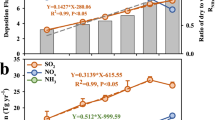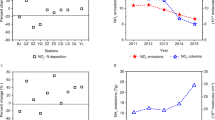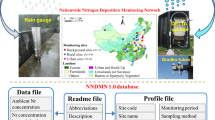Abstract
Increasing atmospheric nitrogen deposition can influence food production, environmental quality and climate change from the regional to global scales. As the largest developing country, China is expected to experience a rapid increase in N deposition. However, the lack of information on dry N deposition limits our understanding of the historical trend of the total N deposition, as well as the main drivers of this trend. Here, we use extensive datasets that include both wet and dry N deposition to evaluate the spatiotemporal variation of N deposition and the changes of its components in China during 1980–2015. Three significant transitions in N deposition in China were observed. First, the total N deposition began to stabilize in 2001–2005, mostly due to a decline in wet NH4+ deposition. Subsequently, a shift to approximately equal wet and dry N deposition occurred in 2011–2015, accompanied by increasing dry deposition. Finally, the contribution of reduced N components in the deposition decreased due to increasing NO3− deposition. These transitions were jointly driven by changes in the socioeconomic structure in China and vigorous controls in N pollution. The three observed important transitions challenge the traditional views about the continuous increase in N deposition in China.
This is a preview of subscription content, access via your institution
Access options
Access Nature and 54 other Nature Portfolio journals
Get Nature+, our best-value online-access subscription
$29.99 / 30 days
cancel any time
Subscribe to this journal
Receive 12 print issues and online access
$259.00 per year
only $21.58 per issue
Buy this article
- Purchase on Springer Link
- Instant access to full article PDF
Prices may be subject to local taxes which are calculated during checkout




Similar content being viewed by others
Data availability
The data that support the findings of this study are available from the corresponding author upon request. The data sources for the NO2 column, NH3 column, social statistics, and NH3, NOx and SO2 emissions can be found in the Methods.
Code availability
The code used to generate and process NH3 column data can be accessed on request to Y.J.
References
Galloway, J. N. et al. Nitrogen cycles: past, present, and future. Biogeochemistry 70, 153–226 (2004).
Liu, X. et al. Nitrogen deposition and its ecological impact in China: an overview. Environ. Pollut. 159, 2251–2264 (2011).
Fowler, D. et al. The global nitrogen cycle in the twenty-first century. Phil. Trans. R. Soc. B 368, 20130164 (2013).
Rennenberg, H. & Gessler, A. Consequences of N deposition to forest ecosystems—recent results and future research needs. Water Air Soil Pollut. 116, 47–64 (1999).
Moran-Zuloaga, D., Dippold, M., Glaser, B. & Kuzyakov, Y. Organic nitrogen uptake by plants: reevaluation by position-specific labeling of amino acids. Biogeochemistry 125, 359–374 (2015).
Nair, R. K., Perks, M. P., Weatherall, A., Baggs, E. M. & Mencuccini, M. Does canopy nitrogen uptake enhance carbon sequestration by trees? Glob. Change Biol. 22, 875–888 (2016).
Song, M. H., Zheng, L. L., Suding, K. N., Yin, T. F. & Yu, F. H. Plasticity in nitrogen form uptake and preference in response to long-term nitrogen fertilization. Plant Soil 394, 215–224 (2015).
Galloway, J. N. Acid deposition: perspectives in time and space. Water Air Soil Pollut. 85, 15–24 (1995).
Stevens, C. J., Dise, N. B., Mountford, J. O. & Gowing, D. J. Impact of nitrogen deposition on the species richness of grasslands. Science 303, 1876–1879 (2004).
Galloway, J. N. et al. Transformation of the nitrogen cycle: recent trends, questions, and potential solutions. Science 320, 889–892 (2008).
Reay, D. S., Dentener, F., Smith, P., Grace, J. & Feely, R. A. Global nitrogen deposition and carbon sinks. Nat. Geosci. 1, 430–437 (2008).
Templer, P. H., Pinder, R. W. & Goodale, C. L. Effects of nitrogen deposition on greenhouse-gas fluxes for forests and grasslands of North America. Front. Ecol. Environ. 10, 547–553 (2012).
Van Groenigen, J. W. et al. Sequestering soil organic carbon: a nitrogen dilemma. Environ. Sci. Technol. 51, 11503–11504 (2017).
Dentener, F. et al. Nitrogen and sulfur deposition on regional and global scales: a multimodel evaluation. Glob. Biogeochem. Cy. 20, GB4003 (2006).
Liu, X. et al. Enhanced nitrogen deposition over China. Nature 494, 459–462 (2013).
Lü, C. & Tian, H. Spatial and temporal patterns of nitrogen deposition in China: synthesis of observational data. J. Geophys. Res. 112, D22S05 (2007).
Jia, Y. et al. Spatial and decadal variations in inorganic nitrogen wet deposition in China induced by human activity. Sci. Rep. 4, 3763 (2014).
Zhu, J. et al. The composition, spatial patterns, and influencing factors of atmospheric wet nitrogen deposition in Chinese terrestrial ecosystems. Sci. Total Environ. 511, 777–785 (2015).
Pan, Y. P., Wang, Y. S., Tang, G. Q. & Wu, D. Wet and dry deposition of atmospheric nitrogen at ten sites in Northern China. Atmos. Chem. Phys. 12, 6515–6535 (2012).
Xu, W. et al. Quantifying atmospheric nitrogen deposition through a nationwide monitoring network across China. Atmos. Chem. Phys. 15, 12345–12360 (2015).
Zhao, Y. et al. Atmospheric nitrogen deposition to China: a model analysis on nitrogen budget and critical load exceedance. Atmos. Environ. 153, 32–40 (2017).
Li, Y. et al. Increasing importance of deposition of reduced nitrogen in the United States. Proc. Natl Acad. Sci. USA 113, 5874–5879 (2016).
Holland, E. A., Braswell, B. H., Sulzman, J. & Lamarque, J. F. Nitrogen deposition onto the United states and western Europe: synthesis of observations and models. Ecol. Appl. 15, 38–57 (2005).
Zhang, L. et al. Nitrogen deposition to the United States: distribution, sources, and processes. Atmos. Chem. Phys. 12, 4539–4554 (2012).
Du, E. et al. Changes in wet nitrogen deposition in the United States between 1985 and 2012. Environ. Res. Lett. 9, 095004 (2014).
Ianniello, A. et al. Chemical characteristics of inorganic ammonium salts in PM2.5 in the atmosphere of Beijing (China). Atmos. Chem. Phys. 11, 10803–10822 (2011).
Liu, X. et al. Evidence for a historic change occurring in China. Environ. Sci. Tech. 50, 505–506 (2016).
Vet, R. et al. A global assessment of precipitation chemistry and deposition of sulfur, nitrogen, sea salt, base cations, organic acids, acidity and pH, and phosphorus. Atmos. Environ. 93, 3–100 (2014).
Kuzyakov, Y. & Xu, X. Competition between roots and microorganisms for nitrogen: mechanisms and ecological relevance. New Phytol. 198, 656–669 (2013).
Sievering, H., Tomaszewski, T. & Torizzo, J. Canopy uptake of atmospheric N deposition at a conifer forest: part I—canopy N budget, photosynthetic efficiency and net ecosystem exchange. Tellus B 59, 483–492 (2007).
Thomas, R. Q., Canham, C. D., Weathers, K. C. & Goodale, C. L. Increased tree carbon storage in response to nitrogen deposition in the US. Nat. Geosci. 3, 13–17 (2010).
McKane, R. B. et al. Resource-based niches provide a basis for plant species diversity and dominance in arctic tundra. Nature 415, 68–71 (2002).
Ashton, I. W., Miller, A. E., Bowman, W. D. & Suding, K. N. Niche complementarity due to plasticity in resource use: plant partitioning of chemical N forms. Ecology 91, 3252–3260 (2010).
Gavrichkova, O. & Kuzyakov, Y. Ammonium versus nitrate nutrition of Zea mays and Lupinus albus: effect on root-derived CO2 efflux. Soil Biol. Biochem. 40, 2835–2842 (2008).
Li, X. et al. The contrasting effects of deposited NH4 + and NO3 − on soil CO2, CH4 and N2O fluxes in a subtropical plantation, southern China. Ecol. Eng. 85, 317–327 (2015).
Boersma, K., Eskes, H. & Brinksma, E. Error analysis for tropospheric NO2 retrieval from space. J. Geophys. Res. 109, D04311 (2004).
Boersma, K. et al. An improved retrieval of tropospheric NO2 columns from the Ozone Monitoring Instrument. Atmos. Meas. Tech. 4, 1905–1928 (2011).
Boersma, K. et al. Intercomparison of SCIAMACHY and OMI tropospheric NO2 columns: observing the diurnal evolution of chemistry and emissions from space. J. Geophys. Res. 113, D16S26 (2008).
Hilton, F. et al. Hyperspectral Earth observation from IASI: five years of accomplishments. Bull. Am. Meteorol. Soc. 93, 347–370 (2012).
Van Damme, M. et al. Global distributions, time series and error characterization of atmospheric ammonia (NH3) from IASI satellite observations. Atmos. Chem. Phys. 14, 2905–2922 (2014).
Clarisse, L., Clerbaux, C., Dentener, F., Hurtmans, D. & Coheur, P. F. Global ammonia distribution derived from infrared satellite observations. Nat. Geosci. 2, 479–483 (2009).
Liu, L. et al. Temporal characteristics of atmospheric ammonia and nitrogen dioxide over China based on emission data, satellite observations and atmospheric transport modeling since 1980. Atmos. Chem. Phys. 15, 9365–9378 (2017).
Jia, Y. et al. Global inorganic nitrogen dry deposition inferred from ground- and space-based measurements. Sci. Rep. 6, 19810 (2016).
Arino, O., Ramos, J., Kalogirou, V., Defourny, P. & Achard, F. In Proc. ESA Living Planet Symposium (2010).
Lieth, H. Primary production: terrestrial ecosystems. Hum. Ecol. 1, 303–332 (1973).
Zhang, Q. et al. Asian emissions in 2006 for the NASA INTEX-B mission. Atmos. Chem. Phys. 9, 5131–5153 (2009).
Li, M. et al. Mapping Asian anthropogenic emissions of non-methane volatile organic compounds to multiple chemical mechanisms. Atmos. Chem. Phys. 14, 5617–5638 (2014).
Zheng, B. et al. High-resolution mapping of vehicle emissions in China in 2008. Atmos. Chem. Phys. 14, 9787–9805 (2014).
Liu, F. et al. High-resolution inventory of technologies, activities, and emissions of coal-fired power plants in China from 1990 to 2010. Atmos. Chem. Phys. 15, 13299–13317 (2015).
Cornell, S. E. et al. Organic nitrogen deposition on land and coastal environments: a review of methods and data. Atmos. Environ. 37, 2173–2191 (2003)
Acknowledgements
This work was supported by the National Key Research and Development Program of China (2016YFA0600104 and 2017YFA0604803), Chinese Academy of Sciences Priority Research Program (XDA19020302), National Natural Science Foundation of China (31872690, 31700377, 31570471 and 31290221), programme of the Youth Innovation Research Team Project (LENOM2016Q0005), National Postdoctoral Program for Innovative Talents (BX20180300) and Newton Fund through the BBSRC project of the China Virtual Joint Centre for Improved Nitrogen Agronomy (BB/N013468/1).
Author information
Authors and Affiliations
Contributions
G.Y. designed the research. Y.J., N.H., J.Z., H.H., X.G. and P.L. conducted the research (collected the datasets and analysed the data). G.Y., Y.J., N.H., S.P., X.L., K.G. and J.Z. wrote the manuscript. Q.W., W.Z., G.D. and Z.C. commented on the manuscript.
Corresponding author
Ethics declarations
Competing interests
The authors declare no competing interests.
Additional information
Publisher’s note: Springer Nature remains neutral with regard to jurisdictional claims in published maps and institutional affiliations.
Supplementary information
Supplementary Information
Supplementary description, Supplementary Figs. 1–16 and Supplementary Tables 1–11
Rights and permissions
About this article
Cite this article
Yu, G., Jia, Y., He, N. et al. Stabilization of atmospheric nitrogen deposition in China over the past decade. Nat. Geosci. 12, 424–429 (2019). https://doi.org/10.1038/s41561-019-0352-4
Received:
Accepted:
Published:
Issue Date:
DOI: https://doi.org/10.1038/s41561-019-0352-4
This article is cited by
-
Elevation-dependent pattern of net CO2 uptake across China
Nature Communications (2024)
-
Nitrogen and phosphorus trends in lake sediments of China may diverge
Nature Communications (2024)
-
Maximizing carbon sequestration potential in Chinese forests through optimal management
Nature Communications (2024)
-
The response of needle stoichiometry to 10-year N addition and 4-year cessation of N addition in a subtropical Masson pine plantation of China
Plant and Soil (2024)
-
Nitrogen deposition mediates more stochastic processes in structuring plant community than soil microbial community in the Eurasian steppe
Science China Life Sciences (2024)



